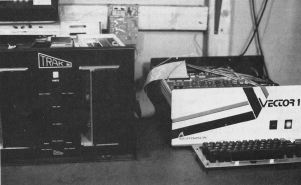 <-
What it looked like.
<-
What it looked like. | BBS was here before the WWW. |
1978: The First Computer Bulletin Board System, CBBS, Goes Online
 <-
What it looked like.
<-
What it looked like.
Two 8" floppy disks driven by A S-100 board and a 300bps modem.
During a meeting of BBS industry folk in 1993 named the 2nd Annual ONE BBSCON, the host had everyone in the room stand up. Then he asked those who did not run a BBS to sit. Then those who didn't have a Board in 1992. Then 1991, 1990, and so forth year by year.
When he reached 1978 only one person was still on his feet... As he stood there
alone the host said, "Folks, meet Ward Christensen.
Ward Christensen and Randy Suess develop the Computerized Bulletin Board System (CBBS) in Chicago. Opened to the public the following year, it is the first electronic message-posting network.
Christensen, a physicist by education and a mainframe programmer by profession, was an electronics hobbyist in his spare time. By the late 1970s he had become expert at programming computers to transfer files from one machine to another via modems and telephone lines.
Christensen and Suess lived in Chicago, where winters bring below-freezing temperatures and piles of snow, and in January 1978 there was plenty of indoor time for programming and fiddling with digital equipment. The idea had been building for awhile, and that winter they decided to devise a simple computer communication system. Christensen developed the software and Suess assembled the hardware.
On February 16, 1978, their system is complete; they name it the Computerized Bulletin Board System (CBBS). When it finally goes online to the public in 1979, Christensen manages the system under the title "system operator" (soon shortened to "sysop"). CBBS operates like a virtual thumb-tack bulletin board. Participants can post messages to a public "board," and others can read and respond to those messages, creating an ongoing virtual discussion.
In November 1978 Christensen and Suess publish an article in Byte magazine, describing CBBS and outlining the technology for devising virtual bulletin boards. The article drums up interest in CBBS and gives others the opportunity to build their own systems.
Since the ARPAnet is still restricted to defense-funded institutions, CBBS is the first civilian experiment in creating virtual community (apart from time-sharing systems). In 1979 most individuals who own computers and modems -- or have access to and knowledge of computing hardware -- are computer hobbyists and scientists. So at first, most topics on CBBS hover within the realm of computers and electronic communication, but eventually the talk broadens.
CBBS kindles a revolution in electronic communication. Virtual bulletin boards begin popping up around the country; they are given the generic name BBS, for bulletin board system. Some cover a range of topics, and others are intended for highly specific discussions. By the early 1990s most BBSs are connected to the Internet, and a whole new virtual world is introduced to BBS members, who had previously roamed within the limited parameters of one system (or in some cases several interconnected systems).
In the mid-1990s membership to BBSs begins to decrease, as the graphics-oriented
World Wide Web bursts on the scene and grabs computer users' attention.
Go Back to the Internet History.
![]()